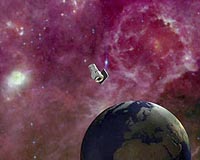 |
Boulder CO (SPX) Mar 22, 2011 New Horizons is ready to put another planet - or at least the planet's orbit - in its rearview mirror. The Pluto-bound spacecraft crosses the path of Uranus around 6 p.m. EDT on March 18, more than 1.8 billion miles from Earth. "New Horizons is all about delayed gratification, and our 9 1/2-year cruise to the Pluto system illustrates that," says Principal Investigator Alan Stern, of the Southwest Research Institute. "Crossing the orbit of Uranus is another milepost along our long journey to the very frontier of exploration." New Horizons is headed for a rendezvous with planet Pluto and its three moons in July 2015 and, soon after, possible encounters with smaller bodies in the distant Kuiper Belt. The fastest spacecraft ever launched, New Horizons has already covered serious space since lifting off in January 2006 - traversing 20 times the distance between Earth and the sun, including a flight through the Jupiter system in 2007 for a gravity-assisted speed boost and scientific observations of the giant planet and its largest moons. "This mission is a marathon," says Project Manager Glen Fountain, of the Johns Hopkins University Applied Physics Laboratory. "The New Horizons team has been focu sed on keeping the spacecraft on course and preparing for Pluto. So far, so good, and we are working to keep it that way." When has New Horizons passed the other planetary orbits? Check here. No pictures of Uranus are planned - the gas giant is 2.4 billion miles from New Horizons and the spacecraft is currently in electronic sleep mode - but the mission team on Earth is busy enough, putting final touches on its Pluto-encounter plan and, in April, starting a search for potential flyby targets in the Kuiper Belt. Preparations are also under way for the annual spacecraft systems checkout this spring. Next planetary milestone on New Horizons' voyage is the orbit of Neptune, which it crosses on Aug. 25, 2014 - exactly 25 years after Voyager 2 made its historic exploration of that giant planet.
Share This Article With Planet Earth
Related Links Pluto at APL The million outer planets of a star called Sol
 Can WISE Find The Hypothetical Tyche In Distant Oort Cloud
Can WISE Find The Hypothetical Tyche In Distant Oort CloudWashington DC (SPX) Feb 21, 2011 In November 2010, the scientific journal Icarus published a paper by astrophysicists John Matese and Daniel Whitmire, who proposed the existence of a binary companion to our sun, larger than Jupiter, in the long-hypothesized "Oort cloud" - a faraway repository of small icy bodies at the edge of our solar system. The researchers use the name "Tyche" for the hypothetical planet. Their paper argues ... read more |
|
| The content herein, unless otherwise known to be public domain, are Copyright 1995-2010 - SpaceDaily. AFP and UPI Wire Stories are copyright Agence France-Presse and United Press International. ESA Portal Reports are copyright European Space Agency. All NASA sourced material is public domain. Additional copyrights may apply in whole or part to other bona fide parties. Advertising does not imply endorsement,agreement or approval of any opinions, statements or information provided by SpaceDaily on any Web page published or hosted by SpaceDaily. Privacy Statement |